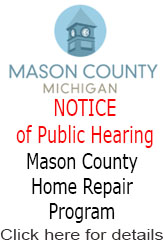By Rob Alway. Editor-in-Chief.
WEARE TWP. (Oceana County) — Mason-Oceana 911 is expected to request a millage during the August 5 primary. The emergency dispatch center is in the final stages of requesting a .14 millage for six years, once the request is approved next week by the Mason County Board of Commissioners.
Director Ray Hasil said the new millage request is the result of persistant declines in local telephone line surcharge revenues, which account for 80% of the agency’s funding.
“Compared to 2012, the 2013 local surcharge revenues were down 4.50%. Compared to 2009, we’re down 11.22%.
“The reasons for a decline in our local surcharge revenue boils down to two reasons,” Hasil said. “Prepaid plans and the number of (year-round) occupied vs vacant homes in the two-county area.” Traditionally, cell phone users have been on annual plans where a bill is sent every month. “As long as that bill is sent to an Oceana or Mason county address the local surcharge dollars come here to Mason-Oceana 911.”
When users switch to a prepaid plan, the revenue model changes radically. “Prepaid plans and minutes can be purchased anywhere; online, department stores, and gas stations. A 1.92% tax is applied at the point of sale; the tax dollars are collected from around the entire state and redistributed; 17.5% is taken off the top for funding things like 911 training and reimbursing local exchange providers for the costs related to wireless emergency service. The remaining 82.5% is redistributed to counties on a 60-40 formula. 60% is distributed based on population, and 40% is distributed based on the numbers of counties in Michigan. “Saying we get back 50% of what we used to under a monthly plan is being very optimistic. I wish there were a way to measure it.”
The other problem lies in the number of occupied versus vacant houses in the two-county area. “It was an eye-opener for our board,” Hasil said. “Only 60.5% of Oceana County houses and 70.9% of Mason County houses are occupied year-round, compared to the state average of 84.3% (2008-2012 American Community Survey, www.census.gov). That’s huge because these homeowners are disconnecting their home phones and their cell phone billing addresses aren’t in either county. In a case where the homeowner disconnects the house phone and their cellular phone bill is sent out of state, 911 gets $0 annually. The surge in people coming to the area and occupying those homes from Memorial Day through Labor Day is in line with the rise in incidents called in to 911. Call volumes typically double and triple versus the off-season and in many cases they don’t contribute to Mason-Oceana 911 services at all because of how the funding mechanisms are structured.”
These issues have caused a dramatic increase in the 911 budget.
“As we began budgeting for 2014 last year it was obvious there was a huge shortfall”, said Hasil.
“Services traditionally paid by 911 could not be budgeted for in 2014,” Hasil said. Wireless broadband connections and software licensing allow fire, law, and EMS agencies to connect to 911’s Computer Aided Dispatch (CAD) system with in-car laptops. “Wireless broadband and CAD connectivity for laptops is $43,000 per year alone.” Agencies were notified late in 2013 that 911 would not be able to pay those fees for 2014.
Budget cuts for 2014 included personnel costs. “We cut 5% in personnel costs out of the 2014 budget. On average, every 911 employee will earn 5% less in wages than 2013.” Staffing hours were reduced wherever possible. “We went from three dispatchers to two anywhere we could without affecting public safety.”
With a 2014 budget in place efforts were set on years 2015 and beyond. “We asked both county administrators to sit as ad hoc members on the 911 Finance Committee. Mason County Administrator Fabian Knizacky and Oceana County Administrator Sue Johnson participated in several meetings to observe and provide feedback on 911’s financial health and plans for recovery. “They helped us quite a bit.”
Hasil and the 911 Board sought a solution more inclusive of those vacant homes. A new surcharge revenue was identified to help the declining local revenue stream.
“Without question a new millage was not desirable,” Hasil said. The board was initially adamant in avoiding anything requiring a ballot. But audit results, local surcharge revenue projections, and budget projections for 2015-2017 painted a grim picture. Even with $681,643 in grant monies awarded to consolidate shared 911 technologies with Newaygo County, we are still short $214,071 in 2015, $693,489 in 2016, and $310,480 in 2017.”
A .12 rate was originally identified but bumped up to .14 to allow the outright purchase versus lease of a required $500,000 radio system upgrade in 2016. If passed the proposal would generate $396,667 in the two-county area in it’s first year. That translates to $7 per year per $50,000 of taxable value.”
The request was approved by the Oceana County Finance and Equalization Committee and Oceana County Board of Commissioners on April 24. The request was brought before the Mason County Finance, Personnel, and Rules Committee on April 22 and is expected to be recommended to the Mason County Board of Commissioners on May 13.
“This is our last resort,” Hasil said. “Further cuts will put the public and responders at risk.”

































































.jpg)
